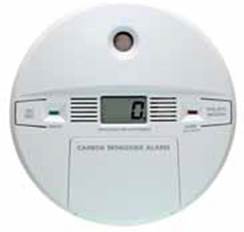Carbon monoxide gas is odorless, colorless, and dangerous. But did you know that common indoor heaters, boilers, and generators can malfunction and produce dangerous levels of carbon monoxide? Every year, hundreds of people die from accidental exposure to carbon monoxide.
In late December, Navien, a manufacturing company specializing in tankless water heaters and boilers released a recall of three models of their products. The recall notes a malfunctioning kit converting natural gas to propane that “can produce excessive amounts of carbon monoxide”.

Navien stated “consumers should immediately stop using the recalled water heaters and boilers that are using propane gas” due to risk of carbon monoxide buildup. Navien will repair the affected products at their own expense. Customers can call 1-800-244-8202 for more information or to arrange repair.
Thankfully, nobody has been hurt by this recall, but it illustrates the potential for danger.
Why is carbon monoxide exposure dangerous?
Carbon monoxide (“CO”) can kill. Carbon monoxide poisoning occurs when carbon monoxide builds up in the bloodstream: symptoms such as dizziness, weakness, confusion, chest pain, vomiting, or loss of consciousness can appear.
At its worst severity, carbon monoxide prevents oxygen from reaching vital organs in the body, which can shut them down.
According to the Center for Disease Control (CDC), fatalities as a result of carbon monoxide poisoning increase during the winter months. In 2015 alone, 393 deaths were reportedly caused by carbon monoxide poisoning, with 36% of those deaths occurring in the winter.
How can you lower the risk of Carbon Monoxide poisoning?
As the winter grows harsh and temperatures continue to drop, make sure that you have precautions in place in the event that carbon monoxide builds up in your home.
The CDC recommends:
- Install carbon monoxide detectors near every sleeping area in your home

- Never use portable generators or flameless chemical heaters inside of your home
- Never run your car or truck inside a garage that is attached to a house, even with the garage door open. If you have a detached garage, open the door to let in fresh air when you run a car or truck inside.
- If you drive a car or SUV with a tailgate, when you open the tailgate also open the vents or windows to make sure air is moving through the vehicle. If only the tailgate is open CO from the exhaust will be pulled into the car or SUV.
- Never use a gas range or oven for heating. Using a gas range or oven for heating can cause a build up of CO inside your home, cabin, or camper.
- Never burn charcoal indoors. Burning charcoal – red, gray, black, or white – gives off CO.
- Never use a portable gas camp stove indoors. Using a gas camp stove indoors can cause CO to build up inside your home, cabin, or camper.
The CDC also recommends routine precautionary measures:
- Replace your CO detector every five years
- Check CO detector batteries when you change your clock for Daylight Savings each spring and fall
- Have your oil or gas furnaces, water heaters or other oil, gas, wood or coal burning appliances inspected every year
- Have a mechanic check the exhaust system of your car or truck every year. A small leak in the exhaust system can lead to a build up of CO inside the car.
While following the CDC’s guidelines, you also should check the Consumer Product Safety Commission’s (CPSC) website. Product recalls, along with potential remedies, are listed to disperse knowledge of flaws quickly. If products you use or own are listed on the CPSC’s website, following the instructions can help keep you safe.
Following the safety guidelines is essential to reducing your risk for carbon monoxide poisoning. If you believe you are experiencing carbon monoxide poisoning symptoms, contact emergency personnel immediately.
If you or someone you know developed carbon monoxide poisoning after using a product that has been recalled – or has become injured after any product you think may not have designed properly – SUGARMAN’s personal injury lawyers can help. Fill out a Contact Form, call us at 617-542-1000 or email . We will respond as soon as possible.

